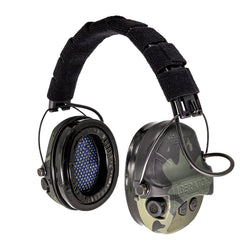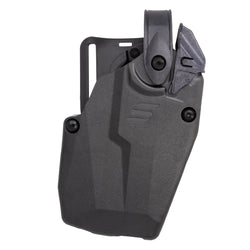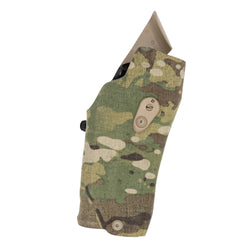Springfield Armory is synonymous with the M1A rifle, but it wasn’t until 2016 that their first AR-15 variant hit the market. The entry-level Saint and upgraded Saint Victor series have been well represented since their inception.
If you are an armed citizen looking for the first or next AR, or an LEO looking for a patrol rifle, Springfield Armory might be on your radar. Recently, Springfield has updated their Saint Victor lineup, and I had the chance to run the new Springfield Saint Victor 14-inch 5.56mm carbine. Here is a first look.
The Springfield Saint Victor: What’s New?
The Springfield Armory Saint Victor is more varied in the catalog over the original Saint and is available as a 9mm pistol or .300 BLK rifle, as well as the standard 5.56x45mm NATO chambering. It also upgrades the no-frills handguard, GI trigger, and furniture of that model as well.

The Saint Victor 14-inch carbine is new to the expanding catalog. It features a 14-inch Melonite-treated 1:8 twist barrel with a three-prong flash hider to get to the minimum legal length of 16 inches. Around the barrel is a free-floating 15-inch aluminum M-LOK handguard with a section of Picatinny rail that runs from the muzzle over to the upper receiver. The rail wears a pair of Springfield’s folding back-up iron sights but will take an optic of your choice.
The Saint Victor is a direct gas AR with a carbine-length gas system. As with other rifles in the Springfield lineup, the Saint Victor uses a 7075 T6 aluminum upper receiver with M4 feed ramps and a matching lower receiver.

The carbine wears an adjustable B5 Systems SOPMOD stock and Type 23 pistol grip, as well as a B5 winter trigger guard for gloved use. The controls include an ambi-friendly magazine release on both sides and a Radian Raptor LT charging handle.

The ambidextrous safety switch is in the usual location above the pistol grip, but the throw has been shortened from 90 degrees to 60 degrees. The rifle also comes with forward and rearward QD mounts for versatile sling installation. Other features include a nickel-boron-coated flat-faced trigger and fire control group.

The rifle ships with one Magpul PMAG and a padded black nylon case with individual compartments for two magazines.
Springfield Saint Victor Quick Specs:
- Caliber: 5.56x45mm NATO
- Capacity: 30+1
- Action: Semi-automatic direct-gas impingement
- Barrel Length: 14.5 inches (16 inches with brake)
- Overall Length: 32-35.5 inches
- Length of Pull: 11-14.5 inches
- Weight: 6.6 lbs. (unloaded)
Springfield Saint Victor: Shooting Impressions
AR-15s from the big-name manufacturers have been something of a pursuit of mine. I like to see their value at their price point, where they skimp, and where they shine. My personal rifle is an old M&P 15 Sport II, and I have plenty of trigger time with rifles like the Colt M5, Ruger AR-556, and the original Saint Victor.
So where does the new Saint Victor stack up? After 300 rounds downrange, I learned that the Saint Victor has well-thought-out and needed controls, and better accuracy than it ought to have.

Ergonomics
Springfield got the Saint Victor right by going with ambidextrous controls, even though it doesn’t have a fully ambidextrous lower. It lacks an ambidextrous bolt release, though moving to safe still requires a minor grip adjustment.
The safety selector is easier and faster to flick off with the shooting thumb thanks to its shorter throw, but no easier to render the safe position than the old-style switch. Going from fire to safe still requires something of a grip shift.

In terms of shouldering, the Saint Victor gets better marks. The SOPMOD stock has more than enough adjustment and has a rubber buttpad, which anchors in the shoulder with authority and dampens what little recoil 5.56 NATO generates.
The flared cheek rest seen on the stock gives the shooter a natural point of contact with the stock, whether it is on the right or left side. I was not wanting for more or having my face in space like with a conventional A2 buttstock, where the check rests against the buffer tube housing.
Accuracy and reliability
From the factory, the Springfield Saint Victor came lightly lubed, and after a quick cleaning and re-lubing, it was on the firing line on day one.
Three hundred rounds later, the carbine cycled 300 times and fired just as many. I fed the Saint Victor a number of brass-cased ammunition, including the .223 Remington Barnes 55 grain JHP, Hornady Frontier 55 grain M193, ADI 55 grain and 69 grain Blitzkings, as well as Winchester M193 5.56×45 NATO rounds.
I even dove into my stash of MagPul, Mission First Tactical, and surplus GI magazines. All of these rounds worked well. I even went through a few boxes of old 55-grain .223 TulAmmo steel-cased ammunition and expected at least a few light primer strikes. Again, the Saint Victor ate it.
In terms of accuracy, the TulAmmo load was the chief loser. From the bench with Saint Victor hooked up to the EOTech Vudu X 2-12 riflescope, I could get five rounds into a four-inch group at 100 yards. The other rounds managed to come in at the 1.5 to 2.5 inch range.
From experience, the ADI 69 grain Blitzking is capable of tight groups, but the Springfield’s 1:8 twist does not quite agree with this heavier round. The Barnes 55-grain hollow-point round was the runaway favorite, consistently turning in 1-inch groups. I didn’t expect that out of a 14-inch pinned-and-welded setup. I certainly did not expect that with the trigger the Saint Victor comes with.
On my Lyman trigger scale, the trigger breaks at just over six pounds. That is an appropriate rate for a GI trigger and takes some effort to cleanly trip. But the flat face and nickel boron treatment seemed to have worked out all the mechanical mush that you get with a two-stage trigger.
The Roundup: Springfield Armory Saint Victor
If you are a fan of Springfield Armory products and you’re after your first AR, feel free to skip the Saint and the longer-barreled models of the Saint Victor and go right for the 14-inch Saint Victor carbine. It gives good accuracy and reliability for a bit of extra weight over the existing Saint Victor models.
The Saint Victor line shows Springfield at its best in terms of reliability and accuracy, with upgraded furniture that’s a welcome addition. Ambidextrous controls, a tuned trigger, and a shorter barrel all point toward a thoughtful package, though the upgrades lean conservative. The ambidextrous features aren’t fully realized, the trigger falls short of a true single-stage aftermarket option, and the 1:8 twist rate limits performance with heavier loads. None of these are dealbreakers, but they may carry more weight at the Saint Victor’s price point, depending on what the individual shooter values most.









